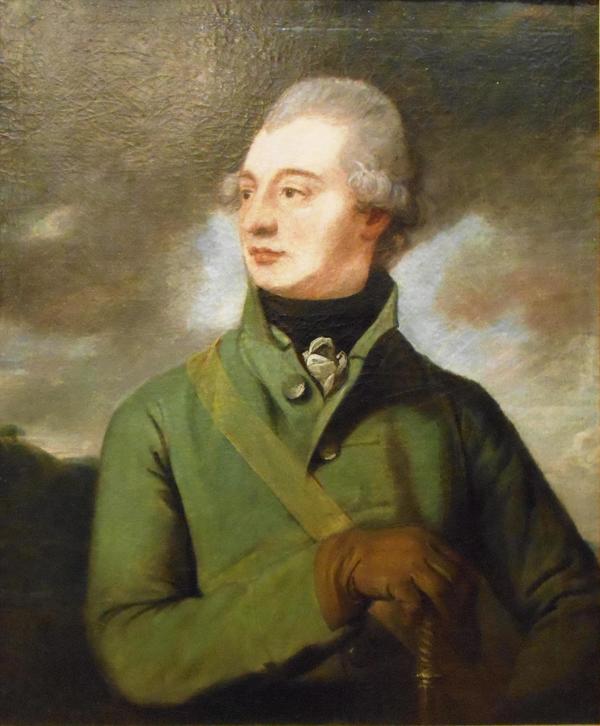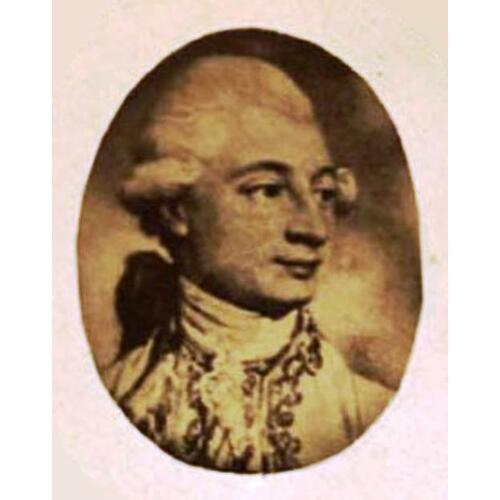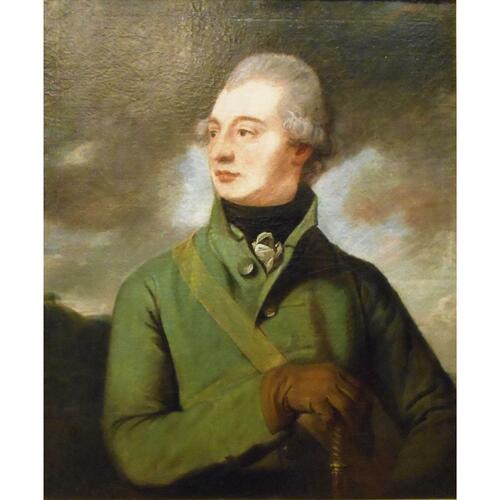
Source: Courtesy of Wikimedia Commons
TARIEU DE LANAUDIÈRE, CHARLES-LOUIS, army and militia officer, seigneur, office holder, politician, and author; b. 14 Oct. 1743 at Quebec, son of Charles-François Tarieu* de La Naudière and Louise-Geneviève Deschamps de Boishébert; d. there 2 Oct. 1811.
Charles-Louis Tarieu de Lanaudière, a godson of Charles de Beauharnois* de La Boische, governor general of New France, came from the seigneurial and military aristocracy. After studying at the Séminaire de Québec from 1752 to 1756, Lanaudière, like many young men of his station, chose a military career, joining the Régiment de La Sarre in 1756. On 28 April 1760 he took part in the battle of Sainte-Foy [see François de Lévis*]; wounded in the leg, he spent some months convalescing at the Hôtel-Dieu in Quebec. In September 1760, after the conquest, he left Canada for France with his regiment and his father accompanied him.
In France Lanaudière rejoined other members of his family and continued his military career as an adjutant. In 1767 he travelled with the ambassador of France, the Comte de Châtelet-Lomont, to the court of King George III in London. Obtaining a passport, he returned to his native land in the spring of 1768 to settle some family matters and take up the legacy bequeathed him by his mother, who had died in 1762. Probably influenced by his father, who had come back to Canada in 1763, Lanaudière took up permanent residence in the colony. He sealed his reintegration into Canadian life by marrying Geneviève-Élisabeth de La Corne, daughter of Luc de La Corne* and Marie-Anne Hervieux, in Montreal on 10 April 1769. They had three children but only one daughter reached adulthood.
Having, with his father’s help, established himself on intimate terms with the British colonial authorities, Lanaudière was appointed aide-de-camp to Governor Guy Carleton, who wanted to use the support of the nobility and the clergy to ensure the submission of the Canadians. In 1770 Lanaudière accompanied his superior to London as a representative of the colony’s inhabitants. In 1771, probably to reinforce his attachment to their side, the British authorities named him surveyor general of woods and waters and offered to make him a baronet. He refused the baronetcy, however, since the oath that he would be required to take was contrary to his religion.
The American invasion in 1775 [see Benedict Arnold; Richard Montgomery*] gave Lanaudière the chance of a military role. Travelling through the countryside around Trois-Rivières, he tried to recruit militia for the defence of Montreal in October. But he met with little success. On reaching Berthier-en-Haut (Berthierville) with an unarmed militia detachment, Lanaudière was attacked by the habitants, taken prisoner, and then released. In November that year he accompanied Carleton when the governor evacuated Montreal and embarked with his troops for Quebec. Contrary winds forced the fleet to stop at Sorel, but, with the help of the ship’s captain Jean-Baptiste Bouchette, Carleton and Lanaudière escaped. In 1777 Lanaudière, along with his father-in-law, took part in the initial phases of Major-General John Burgoyne*’s expedition into New York. Having returned to Quebec in August, he was not present when the Americans defeated the British troops in the autumn.
Lanaudière was a faithful servant of Carleton and in 1778 again accompanied him to Europe. In 1785 he visited Prussia and met King Frederick II, who permitted him to attend his army’s manœuvres in various places. Lanaudière’s attachment to the British authorities was rewarded in 1786, when Carleton (now Lord Dorchester) appointed him to the Legislative Council and made him overseer of highways. These appointments were renewed in 1791; in addition he received the title of superintendent of the postal services.
Lanaudière owned vast tracts, inherited from his mother, in the seigneury of Lac-Maskinongé (also called Lanaudière) and similar holdings, given to him by his father in 1772, in the seigneury of Sainte-Anne-de-la-Pérade. As seigneur he rendered fealty and homage for his properties in 1781 and prepared the recognition of suzerainty and census for them the following year. His seigneuries were still sparsely settled and his revenues from them were therefore slim. In 1783 he placed an advertisement in the Quebec Gazette inviting loyalists to settle his lands on advantageous terms such as a ten-year exemption from rent. In 1788 he presented a memorial to the government requesting that seigneurial tenure be suppressed on his properties in favour of free and common socage. For Lanaudière a change of this sort would have made his seigneuries much more profitable. But the proposed plan displeased the Canadian seigneurs and censitaires, and the request was shelved [see Thomas-Laurent Bédard*; William Smith*]. Despite this rebuff Lanaudière retained an interest in agriculture; in 1789 he subscribed to the Agriculture Society in the District of Quebec, which had been founded that year. He also grew hemp on his lands at Sainte-Anne-de-la-Pérade. However, because he was kept in Quebec by his numerous obligations, Lanaudière did not live on his seigneuries; he entrusted their operation to managers such as Louis Gouin.
Lanaudière was a figure much in the public eye and so he signed addresses of welcome and farewell to British officials, to whom he was completely loyal. In 1792 he was vice-president of the Constitutional Club. Founded that January and composed mainly of British merchants, the club sought to make the constitution better known and to foster economic progress. The government once more recognized Lanaudière’s services by appointing him quartermaster general of the militia in 1799. This new post, together with a number of other offices which were largely honorary but also highly lucrative, provided him with an enviable style of life. He had his home on Rue des Pauvres (Côte du Palais), which despite its name was actually one of the most fashionable streets in Quebec at the end of the 18th century. His household included some servants and slaves.
In the last years of his life Lanaudière continued to carry out the duties of the various offices entrusted to him. He died at Quebec on 2 Oct. 1811 and was buried three days later in the crypt of Notre-Dame. He had adapted well to the change in government. Like many other seigneurs he had in self-interest become intimate with the British, who during that period were trying to enhance the social and economic status of the nobility. In the course of a visit to Lower Canada at the beginning of the 19th century, John Lambert noted that Lanaudière “is one of the most respectable gentlemen in the colony. . . . He is sincerely attached to the English government, and in his conduct, manners, [and] principles, he seems to be an Englishman.”
Charles-Louis Tarieu de Lanaudière is the author of Chanson (Québec, 1792); Le discours suivant, destiné par l’honorable Charles de Lanaudière, pour être prononcé à la dernière assemblée du club constitutionnel; n’a pu l’être parce que plusieurs rapports du comité permanent ont paru devant le club pour avoir sa décision (Québec, 1792); A hand-bill against M. Deschenaux (Quebec, 1792); and Speech to habitants of Ste. Anne (Quebec, 1792).
ANQ-Q, CE1-1, 15 oct. 1743, 7 oct. 1777, 27 mars 1779, 5 oct. 1811, 1er avril 1817; P-244. AP, Notre-Dame de Montréal, Reg. des baptêmes, mariages et sépultures, 10 avril 1769, 28 févr. 1770, 17 sept. 1771. PAC, MG 11, [CO 42] Q, 26–2: 515–16, 518; 35: 416–28; 38: 25–33; 48–1: 5; 51–2: 46–47; 89: 117–23; 90: 346–62; 93: 196–97. “Les dénombrements de Québec” (Plessis), ANQ Rapport, 1948–49: 15, 65, 115, 166. Doc. relatifs à l’hist. constitutionnelle, 1759–1791 (Shortt et Doughty; 1921). Invasion du Canada (Verreau). [L.-A.-A. Prévôt de Montaubert de Merleval], “La campagne du régiment de La Sarre au Canada (1756–1760),” Pierre Héliot, édit., RHAF, 3 (1949–50): 518–36. Quebec Gazette, 2 Aug. 1770, 22 Sept. 1774, 23 June 1785, 6 April 1789, 19 Aug. 1791, 31 May 1792, 13 Feb. 1794, 11 Dec. 1800, 22 July 1802, 15 Jan. 1807. Le Jeune, Dictionnaire, 2: 58. P.-G. Roy, Inv. concessions, vols.2–3. Raymond Douville, Hommes politiques de Sainte-Anne-de-la-Pérade ([Trois-Rivières, Qué.], 1973). Tanguay, Dictionnaire, 7: 262. Turcotte, Le conseil législatif. P.[-J.] Aubert de Gaspé, Mémoires (Ottawa, 1866). Caron, La colonisation de la prov. de Québec, 2. L.-S. Rhéault, Autrefois et aujourd’hui à Sainte-Anne de la Pérade (Trois-Rivières, 1895). P.-G. Roy, La famille Tarieu de Lanaudière (Lévis, Qué., 1922). Sulte, Hist. des Canadiens-français, 7–8. Trudel, L’esclavage au Canada français. Maurice Séguin, “Le régime seigneurial au pays de Québec, 1760–1854,” RHAF, 1 (1947–48): 382–402. Benjamin Sulte, “L’exploit du capitaine Bouchette,” BRH, 5 (1899): 318.
Cite This Article
Yves Beauregard, “TARIEU DE LANAUDIÈRE, CHARLES-LOUIS,” in Dictionary of Canadian Biography, vol. 5, University of Toronto/Université Laval, 2003–, accessed January 7, 2025, https://www.biographi.ca/en/bio/tarieu_de_lanaudiere_charles_louis_5E.html.
The citation above shows the format for footnotes and endnotes according to the Chicago manual of style (16th edition). Information to be used in other citation formats:
| Permalink: | https://www.biographi.ca/en/bio/tarieu_de_lanaudiere_charles_louis_5E.html |
| Author of Article: | Yves Beauregard |
| Title of Article: | TARIEU DE LANAUDIÈRE, CHARLES-LOUIS |
| Publication Name: | Dictionary of Canadian Biography, vol. 5 |
| Publisher: | University of Toronto/Université Laval |
| Year of publication: | 1983 |
| Year of revision: | 1983 |
| Access Date: | January 7, 2025 |




